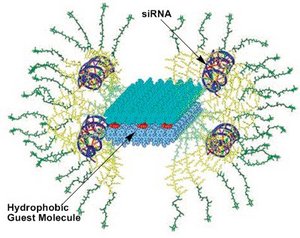For years, scientists have been trying to create
artificial viruses that are as proficient as natural ones in delivering materials to cells. Successful, artificial viruses could carry therapeutic agents into human cells to treat a variety of diseases. Unfortunately, synthesizing an artificial virus with the ideal shape and size for maximum delivery efficiency is extremely difficult. A common method for their generation involves polyion coupling, which often leads to aggregates with uncontrollable dimensions.
The Lee research group at Yonsei University in Seoul, Korea found an alternate strategy, one that used pre-organized supramolecular nanostructures to construct, for the first time, a filament-shaped artificial virus. Filamentous shaped nanostructures last longer in vivo, and many natural viruses are filamentous. The process started with the creation of Glu-KW, a β-sheet peptide based supramolecule. Glu-KW's self-assembeled β-sheet contains two linkers: a nucleic acid-binding segment and a carbohydrate ligand. The β-sheet consists of alternating hydrophobic and charged amino acids, assisting the self-assembly. Glu-KW is coated with glucose to shield the charges on the surface of the β ribbon, which increases the chance of cell binding.

Lee's group proposed that the self-assembled virus can bind to therapeutic agents and deliver it into the cell. They tested their idea using small interfering RNA (siRNA), a double stranded RNA that induces specific post-transcriptional gene-silencing. Based on evidence from circular dichroism and transmission electron microscopy, their artificial virus can make a complex with the negatively charged siRNA. To examine the virus' ability as an intracellular siRNA delivery carrier, the chemists compared Glu-KW with Lipofectamine 2000, a commercial compound with high siRNA transfection efficiencies, using a human cervical cancer cell line. In gene knockdown experiments, Glu-KW performed just as well as Lipofectamine 2000.
In addition to delivering nucleic acids like siRNA, the artificial virus can also carry a hydrophobic guest molecule because the β ribbon bilayer forms a hydrophobic space useful for encapsulation. The chemists tested Glu-KW's potential for delivering nile red, a hydrophobic stain, while the virus was complexed with siRNA. Nile red was delivered to the cytoplasm and nucleus of the cells and gene knockdown still occurred, although with less efficiency.
The β ribbon templates are capable of assembling artificial viruses with favorable sizes and shapes. The virus' simultaneous
ability to deliver genetic materials and hydrophobic therapeutic reagents are particularly useful, and the researchers' approach is flexible and allows for a variety of structural changes to the virus. Until we study the toxicology of these artificial viruses, however, we cannot judge their full potential for treating diseases.
Angewandte, 2008. DOI:
10.1002/anie.200800266

just imagine the potential damage should this get into the wrong hands of 'evil governments' or... 'big pharma' or... oh, too late.